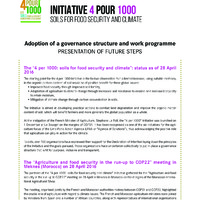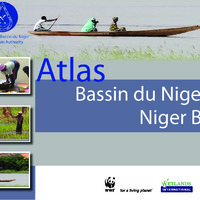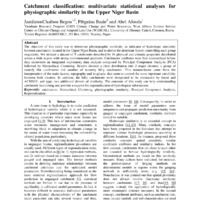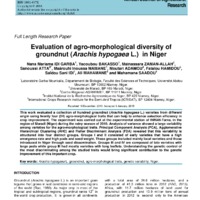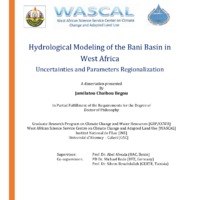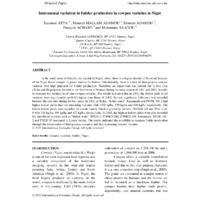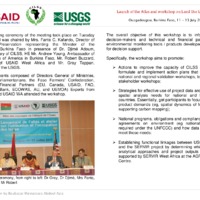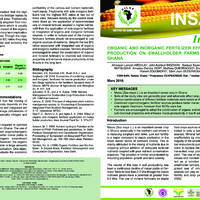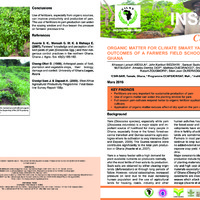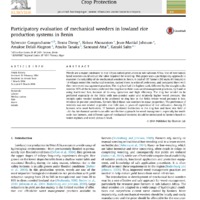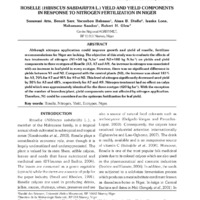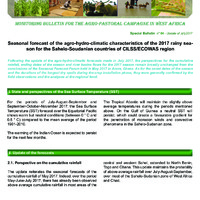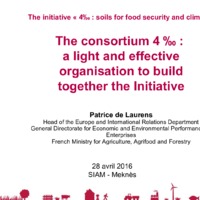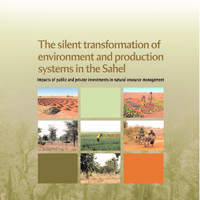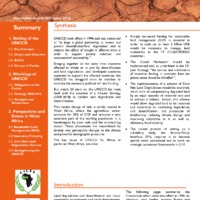Recherche
22 items
Adoption of a governance structure and work programme presentation of future steps
Adoption of a governance structure and work programme PRESENTATION OF FUTURE STEPS
Atlas du bassin du niger
Cet ouvrage est consacré au Niger, le fleuve des fleuves. Ce cours d’eau traverse quatre pays mais son bassin draine neuf (9) Etats d’Afrique de l’Ouest représentant un kaléidoscope de cultures et de paysages. Son nom original, «egerou n-igereou», signifie «fleuve des fleuves». Il lui a été donné par les Touaregs, qui voulurent ainsi souligner le caractère exceptionnel qu’avait pour eux ce cours d’eau. Le fleuve Niger est le 4ème bassin hydrographique d’Afrique avec ses 4.200 km de long et dont le bassin couvre environ 2,1 millions de km2 de superficie totale pour 1,5 millions de km2 de bassin actif. La gestion intégrée de ce potentiel hydrique et de ses écosystèmes associés est un enjeu majeur pour les Etats membres de l’Autorité du Bassin du Niger (ABN) et ses partenaires comme l’attestent les différentes thématiques abordées dans cet ouvrage. Nous sommes aujourd’hui tous conscients des priorités de développement du bassin et j’en suis convaincu que cet ouvrage contribuera à faire mieux connaître le bassin du Niger dans toute sa diversité aux plans tant national qu’international, et servira d’inspiration pour atteindre les objectifs de la Vision partagée. Enfin, cette publication est le témoignage d’une collaboration fructueuse entre l’ABN et deux ONG Internationales partenaires, le Fonds Mondial pour la Nature (WWF) à travers son Programme Eaux douces pour l’Afrique de l’Ouest et Wetlands International.
Catchments classification: multivariate statistical analysis for physiographic similarity in the niger basin
The Bani basin was classified into 4 clusters of similar catchments (Figures 2-4), The topographic variables (Elev, ElevMin, ElevMax, Slo1), precipitation and the geographical position of the sub-catchment (Lat) were demonstrated to be the most important causes of similarity between catchments belonging to Cluster 2 and Cluster 4 (Table 2), This study permitted to propose the two nomenclature: Group of northerly flat and semi-arid catchments, and group of southerly hilly and humid catchments.
consolidated teaching guide on the prevention and management of conflicts in connection with mobile farming
The Integrated Farming Project and Pastoralism and Secure in West Africa (PEPISAO) undertook the design of a teaching guide, for the prevention and management of conflicts related to mobile livestock. This document will provide orderly and practical content for stakeholders in particular, technicians accompanying projects as well as direct stakeholders in the field (POs, transhumance committees, etc.). It should be remembered that the objective of PEPISAO is "to reduce conflicts linked to pastoralism by initiating the construction of a shared regional vision on the different ruminant
farming methods ".
Estimates of Phenotypic and Genotypic Variance and Heritability in Eighty Nine Bambara Groundnut Vigna subterranea (L.) Verdcourt] Accessions Collected from Six Regions of Niger
The bambara groundnut [Vigna subterranea (L.) Verdc. (Fabaceae)] is a legume mainly cultivated by women, for the nutritional quality of these seeds. It is a so-called minor culture and the improvement of the plant and its popularization remains to be promoted. The objective of this present work is to evaluate the genetic variability of bambara groundnut accessions. The experiment was carried out according to a completely randomized block device with four replications. Twenty-two (22) characters including four (4) phenological, four (4) morphological and fourteen (14) related to yield were evaluated for accessions characterization. Descriptive analysis showed significant differences. The coefficients of variation ranged from 3.51% (maturity date) to 38.87% (shell weight). Significantly high values (CV˃20%) for 8 of the metric parameters were observed. Pod weight per plant and seed weight per plant (r=0.943), yield in kg/ha (r=0.943); seed weight per plant and yield in kg/ha (r=0.999) showed the strongest correlations. The phenotypic and genotypic coefficients of variation were high for dry biomass weight (PCV=42.23%; GCV=28.40%), shell weight (PCV=63.46%; GCV=22.46%) and 100-seed weight (PCV=25.57%; GCV=25.25%). Maturity date (95.77%) and 100-seed weight (99.84%) had high heritabilities. Broad-sense heritability and genetic gain are high for 100-seed weight (H2=99.84%; GA=52.58%). The Ascending hierarchical classification produced four groups of which group 4 is the most efficient in yield with short (20.58cm) early accessions (80.32 days). Groups 1 and 2 include, late accessions (~22cm) with respectively maturity dates (DM=85.67 days and DM=86.53 days.
Evaluation of agro-morphological diversity of groundnut (Arachis hypogaea L.) in Niger
This work evaluated a collection of hundred groundnut (Arachis hypogaea L.) varieties from different origin using twenty four (24) agro-morphological traits that can help to enhance selection efficiency in crop improvement. The experiment was carried out at the experimental station of INRAN-Tarna, in the region of Maradi (Niger) during the rainy season of 2010. Analysis of variance showed a large variability among varieties for the agro-morphological traits. Principal Component Analysis (PCA), Agglomerative Hierarchical Clustering (AHC) and Fisher Discriminant Analysis (FDA) revealed that this variability is structured into four distinct groups. Groups I and II consisted of early varieties that have a high emergence rate and high pods and seed weight. These groups included mainly local varieties and those introduced in Niger through seed dissemination. Groups III and IV are composed of late varieties with large pods while group III had mostly varieties with long leaflets. Understanding the genetic control of the most discriminating among the studied traits would bring significant contribution to the genetic improvement of this important crop.
Expanding capacity for translating seasonal climate forecasts into actionable information for agriculture and water sectors in West Africa: Lessons learnt and way forward
With climate change and variability posing challenges to sub-Saharan Africa’s development sectors, weather and climate information services are crucial for building climate-resilient development pathways (Hansen et al., 2022). Seasonal forecasts in particular provide prospective information about the upcoming season, with a particular focus on precipitation and temperature (Guido et al., 2020; Hansen et al., 2011). However, a direct and linear translation of the seasonal forecasts to sector-specific information such as water resources and agriculture can lead to inaccurate recommendations. Integrating seasonal forecast data into biophysical models can enable the generation of sector-relevant actionable information that can improve the decision-making (Hansen, 2005; Houngnibo et al 2023). This would contribute to a better understanding of the impacts of climate forecasts in the water and agriculture sectors, among others, thereby facilitating more informed decision-making.
Regional operational meteorological centers, including AGRHYMET Regional Climate Center for West Africa and the Sahel (AGRHYMET CCR-AOS), are regularly producing seasonal climate forecasts to help inform adaptation decision-making at various levels. As a Regional Climate Center, AGRHYMET CCR-AOS coordinates the development of consensus seasonal forecasts through Regional Climate Outlook Forums (RCOF), which bring together experts from National Meteorological and Hydrological Services (NMHSs), basin organizations, and global climate centers. AGRHYMET CCR-AOS has proposed a new approach to translate seasonal forecasts into sector-specific actionable information for agriculture and water sectors through crop and hydrological models. This is referred to as extended seasonal forecasts in agriculture and water sectors (Houngnibo et al 2023).
As part of AICCRA West Africa cluster activities, AGRHYMET has capacitated NMHSs in West Africa and the Sahel on this approach as a first step towards extended and widespread uptake and utilisation in NMHSs in the region. The capacity building event took place in Ouagadougou, Burkina-Faso from August 7th to 11th, 2023. The objective was to enhance the capacity of NMHSs to use new tools that combine seasonal forecasts with impact models in the agriculture and water resources sectors. This Info Note documents the process, key insights and lessons from the regional capacity building for translating seasonal forecasts into actionable information for agriculture and water sectors in West Africa for a better-informed policy and action decision making.
Hydrological modeling of the bani basin in west africa
De nombreux bassins de drainage à travers le monde ne disposent d’aucune mesure de débit. Les méthodes de régionalisation sont alors généralement utilisées pour les prévisions en bassins non jaugés. L'objectif principal de cette étude est de prévoir les hydrogrammes d’écoulement dans le bassin du Bani afin de contribuer à l’amélioration de la connaissance sur la disponibilité des ressources en eau. Tout d'abord, le modèle hydrologique SWAT a été calibré sur de nombreux bassins jaugés sur la période de 1983-1992 et validé sur la période 1993-1997 en utilisant la méthode « Generalized Likelihood Uncertainty Estimation (GLUE) ». Ensuite, des groupes de bassins similaires ont été déterminés en fonction de leurs caractéristiques physiographiques et climatiques et au moyen d’une analyse statistique multivariée. Deux méthodes de régionalisation basées sur le concept de similarité entre bassins, ont été utilisées : la similarité physique et la proximité spatiale. Dans les deux cas, le jeu de paramètres calés du modèle est entièrement transféré du bassin jaugé vers le bassin non jaugé pour y simuler l’hydrogramme de débits journaliers de la période 1983-1997. Les résultats indiquent une bonne performance du modèle à l’échelle journalière et mensuelle, ainsi qu’à l’échelle du bassin et des sous-basins. La performance du modèle à l’échelle du bassin global et sur un pas de temps journalier est caractérisée par un critère de Nash de 0.76 et 0.84 et un coefficient de détermination de R2 de 0.79 et 0.87 en période de calibration et de validation, respectivement. Aussi, les valeurs absolues du PBIAIS demeurent inferieures à 25&, ce qui témoigne d’une bonne prévision du bilan d’eau. Il est à noter que les incertitudes associées demeurent satisfaisantes malgré les conditions de données limitées qui sous-tendent cette modélisation. Ainsi, 61& des débits observés (P-factor = 0.61) sont compris à l’intérieur de la bande d’incertitude dont la largeur reste adéquate (R-factor = 0.91). La calibration mensuelle a quant à elle permit d’atteindre une meilleure performance du modèle et une diminution des incertitudes à l’exception du bilan d’eau dont les erreurs de prévision semblent avoir augmenté. La calibration a également permis d'identifier 12 paramètres du modèle qui simulent au mieux les débits observés. Les bassins étudiés ont été classes en trois groupes: un groupe de bassins de plaine, semi-arides et situés au Nord, un autre groupe de bassins d’altitude qu’on rencontre dans les zones humides du Sud, et un troisième groupe situé dans le centre du bassin d'étude, à l'intérieur duquel, aucun des descripteurs semble se démarquer significativement des autres. Dans l'ensemble, la régionalisation a donné de bons résultats au niveau de plusieurs bassins cibles. Les meilleurs ont toutefois été enregistrés dans la zone aride et à l’exutoire global du bassin, particulièrement. Cependant, on note également une augmentation des incertitudes précisément dans cette zone. Une bonne similarité hydrologique mutuelle a été mise en évidence entre certains bassins, dont le meilleur indicateur reste la proximité spatiale. La connaissance de la disponibilité des ressources en eaux, particulièrement au niveau des bassins non jauges, est d’une utilité capitale dans plusieurs domaines d’application telles que l'allocation de l'eau pour la consommation et pour l'irrigation surtout en Afrique de l'Ouest qui fait face fréquemment à la gestion des risques liés au déficit en eau et a l'insécurité alimentaire en raison des impacts du changement climatique. Ces résultats contribuent également à une meilleure compréhension du fonctionnement hydrologique d’une zone jusque-là non explorée dans le domaine de la prévision en bassins non jaugés (PUB), et constituent une première étape vers de nouvelles investigations qui contribueront à l’amélioration des prévisions de l’information hydrologique.
Identification of the swat model parameters on the bani catchment (west africa) under limited data condition
Results showed that the model performance can be judged as very good (Moriasi et al., 2007) especially considering limited data condition and high climate, land use and soil type variabilities in the studied basin (Figure 1). Prediction uncertainty is acceptable: most of the observed data (around 80& ) are bracketed by the 95PPU within an acceptable width (R-factor < 1). However, model is characterized by more prediction uncertainties during high flows (Figure 2). The most sensitive parameters are mostly related to surface runoff reflecting the dominance of this process on the streamflow generation (Table 1).
Interannual variation in fodder production in cowpea varieties in Niger
In the south areas of Niamey, the capital of Niger, where there is a higher density of livestock because of the Niger River, cowpea is grown mainly for fodder. Unfortunately, there is a lack of dual-purpose cowpea varieties with high potential for fodder production. Therefore, an experiment was carried out in two sites (Ticko and Bogodjotou) located in the Southwest of Niamey during the rainy season of 2001 and 2002, in order to compare the production of nine cowpea varieties. The results indicated that in 2001, the fodder yield of all varieties were significantly (p<0.01) higher than those of 2002. But not significant difference was recorded between the two sites during the two years. In 2001, at Ticko, “Baban waké", Kanannado and IT93K-398-2 had higher fodder yields than the remaining varieties with 1032 kg/ha, 879 kg/ha and 866 kg/ha respectively. The lowest fodder yields were recorded for Locale variety which is grown by farmers, IT89KD-349 and TVu 1234- 9 with 715 kg/ha, 499 kg/ha and 677 kg/ha, respectively. In 2002, the highest fodder yields were also recorded for introduced varieties such as “Baban waké", IN92E-3, IT89KD-288, IT89KD-349, Kanannado, IT93K-398- 2 and TN256-87 compared to Locale variety. The results indicated the possibility to increase fodder production through the introduction of dual-purpose cowpeas and thus increasing farmers’ income. © 2011 International Formulae Group. All rights reserved.
Participatory evaluation of mechanical weeders in lowland rice production systems in Benin
Weeds are a major constraint to rice (Oryza sativa) production in sub-Saharan Africa. Use of mechanical hand weeders could reduce the labor required for weeding. This paper uses a participatory approach to examine the suitability of six mechanical weeders in Benin. A total of 157 farmers (93 male, 64 female) in 14 villages tested the mechanical weeders, ranked them in order of preference, and compared them with their own weed management practices. The ring hoe had the highest rank, followed by the straight-spike weeder; 97& of the farmers preferred the ring hoe to their own weed management practices, by hand or using traditional hoe, because of its easy operation and high efficiency. The ring hoe tended to be preferred especially in the fields with non-ponded water and relatively higher weed pressure. The straight-spike weeder tended to be preferred to ring hoe in the fields where weed pressure is less, whereas in ponded conditions, farmers liked these two weeders in equal proportion. The preference of weeders was not related to gender, rice field size, or years of experience of rice cultivation. Among 23 farmers who used herbicides, 17 farmers preferred herbicides to the ring hoe and have rice field of >0.5 ha. Mechanical weeders can offer an effective approach for weed management, especially for smallscale rice farmers, and different types of mechanical weeders should be introduced to farmers based on water regimes and weed pressure level.
ROSELLE (HIBISCUS SABDARIFFA L.) YIELD AND YIELD COMPONENTS IN RESPONSE TO NITROGEN FERTILIZATION IN NIGER
Although nitrogen application could improve growth and yield of roselle, fertilizer recommendations for Niger are lacking. The objective of this study was to evaluate the effects of two treatments of nitrogen (N1=50 kg N,ha-1 and N2=100 kg N.ha-1) on yields and yield components in three ecotypes of Roselle (A3, A7 and A9). An increase in nitrogen was associated with an increase in leaf yield in every ecotype. However, there was no significant difference in yields between N1 and N2. Compared with the control plants (N0), the increase was about 181& for A3, 70& for A7 and 95& for A9 at N2. This level of nitrogen significantly decreased seed yield by 30& for A3 and 48&, respectively for A7 and A9. Nitrogen treatment had no effect on calyx yield which was approximately identical for the three ecotype (420 kg ha-1). With the exception of the number of branches/plant, yield components were not affected by nitrogen application. Therefore, N1 could be considered as the optimum fertilization for leaf yield.
Seasonal forecast of the agro-hydro-climatic characteristics of the 2017 rainy season for the Sahelo-Soudano countries of CILSS/ECOWAS region
Following the update of the agro-hydro-climatic forecasts made in July 2017, the perspectives for the cumulative rainfall, ending dates of the season and river basins flows for the 2017 season remain broadly unchanged from the conclusions of the Seasonal Forecast Forum held in May 2017 in Accra, Ghana. As for the onset dates of the season and the durations of the longest dry spells during the crop installation phase, they were generally confirmed by the field observations and the analyses at the regional level.
Seasonal Forecasts of Agro-hydro-climatic characteristics of the major rainy season in the Gulf of Guinea countries (PRESAGG - 2025)
For the 2025 major rainy season in the southern parts of the Gulf of Guinea countries, average to below average rainfall totals are expected in southeastern Nigeria, southwestern Côte d'Ivoire and average to above average rainfall in the southwestern parts of Nigeria, southeastern Ghana and southern Benin, Togo and Côte d'Ivoire; an early to average onset, an early to average cessation and long to average dry spell durations are expected over most of the Gulf of Guinea area; average to above average flows in the western coastal basins and above average to average flows in the eastern coastal basins.
Synergies between the Food System Resilience Program (FSRP) and the Accelerating Impacts of CGIAR Climate Research for Africa (AICCRA) in West Africa: Implementation domains for cross-fertilization
The Food System Resilience Program (FSRP) and the Accelerating Impacts of CGIAR Climate Research for Africa (AICCRA) are two World Bank’s International Development Association (IDA)-funded projects that include West Africa and the Sahel as intervention region. While the first phase of AICCRA is planned for 2021-2023 with a possible 5-years additional financing from 2024 (Zougmoré et al., 2023), the FSRP is a multi-phase long-term commitment program required to build sustainable regional mechanisms and institutions with sufficient substance at a regional level. This multi-phase approach will enable a set of countries with varying degrees of readiness to adopt consistent approaches and accede to regional systems at appropriately differential speeds. Phasing the accession of countries according to their readiness will allow regional mechanisms to operate with maximum effectiveness. While FSRP is aligned to the Economic Community of West Africa States Agricultural Policy (ECOWAP) as the main framework for agricultural transformation and regional integration, and implemented through three major regional organizations, i.e., Economic Community of West African States (ECOWAS), Permanent Interstate Committee for Drought Control in the Sahel (CILSS)’s specialized center AGRHYMET Regional Climate Center and the West and Central African Council for Agricultural Research and Development (CORAF), AICCRA builds on 50 years of CGIAR climate research innovations, especially on the achievements of the CGIAR Research Program on Climate Change, Agriculture and Food Security (CCAFS) to contribute developing a climate-smart African future driven by science and innovation in agriculture. More specifically, AICCRA works to upscale and make climate information services and climate-smart agriculture technologies more accessible to millions of smallholder farmers across Africa. At the same time, FSRP aims to strengthen regional food system risk management, improve the sustainability of the productive base in targeted areas and to develop regional agricultural markets.
In view of the complementarity between the two projects, i.e., AICCRA being a potential provider of scientifically evidence-based innovations, tools and approaches, while the FSRP is a potential user of these knowledge and information, and at the same time both are working on the common topic of supporting resilient agriculture and food systems, the World Bank has fostered active synergy between the two projects since their design phases, in a way to promote a win-win cross-fertilization. Since the commencement of FSRP implementation, clear Program of Work and Budget has been developed, with strategic areas of collaboration in a formal document that will serve as implementing guide to both projects and inform other WB operations in IDA countries and regions in Africa and beyond. This Info Note synthesizes and analyses collaboration domains for synergy and cross-fertilization between AICCRA and FSRP, with focus on the latter’s two regional components led by CILSS/AGRHYMET and CORAF.
The consortium 4 ‰ : a light and effective organisation to build together the initiative
The consortium 4 ‰ : a light and effective organisation to build together the Initiative
United nations convention to combat desertification (UNCCD) : State of play and perspectives for west africa
UNCCD took effect in 1996 and was conceived of "to forge a global partnership to reverse and prevent desertification/land degradation and to mitigate the effects of drought in affected areas in order to support poverty reduction and environmental sustainability." Bringing together at the same time countries affected in whole or in part by desertification and land degradation, and developed countries expected to support the affected countries, the UNCCD has struggled since its creation to mobilise the necessary political will and funding. But, nearly 20 years on, the UNCCD has reset itself with the adoption of a 10-year Strategy (2008-2018) to combat land degradation and desertification. This recent change of tack is sorely needed in West Africa, where the agricultural sector accounts for 35& of GDP and occupies a very extensive part of the working population. It is handicapped by poor soils and the encroaching desert. These phenomena are exacerbated by already very perceptible changes to the climate and powerful demographic pressures. The key issues of UNCCD for Africa, in particular West Africa, are clear: Introduction Land degradation and desertification are major constraints to economic and social development. Inspired by that realisation, African, Latin American, and Mediterranean leaders called into being the UN Convention to Combat Desertification (UNCCD). Translation: Peter Gaechter, SOS Sahel Sharply increased funding for sustainable land management (SLM) is essential in order to scale up: at least 2 billion US$ would be necessary to manage land sustainably in the 17 CILSS/CEDEAO countries ; The Global Mechanism should be implemented and, as underlined in the 10year Strategy, “the sources and mechanisms of innovative funding, in particular from the private sector should be identified ”; The implementation of a scheme of Zero Net Land Degradation should be explored, which aims at compensating degraded land by an equal quantity of restored land and to achieve a balance. Indeed, this scheme would allow degraded land to be restored and contribute to combating degradation and desertification, the protection of biodiversity, reducing climate change, and improving adaptation to it, as well as, obviously, food security; The recent process of setting up a subsidiary body, the Science-Policy Interface (SPI), requires it to become quickly more operational and to work on strategic investment frameworks in SLM.
